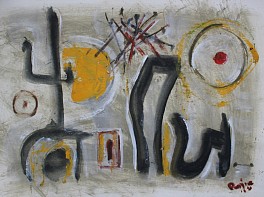BIOGRAPHY

Armenian-American (1914-1999)
Pinajian (1914-1999) was a compatriot and friend of many of the Post-WWII New York School artists, including DeKooning and Gorky. However, when it came to his own work, Pinajian was a hoarder and put very little energy and time into showing his art. After his death in 1999, five decades of accumulated artwork were found in a Bellport, Long Island, cottage he shared with his sister. In the years before his death, Pinajian implored his sister simply to “throw it all away.” Fortunately, at the last moment, this massive body of work was rescued by a close cousin.
In 2007, the late Dr. William Innes Homer, a noted art historian, agreed to study the collection and was stunned by what he found: an almost bewildering array of extraordinary abstract landscape and figurative paintings by a gifted artist who was completely unknown in his lifetime. Homer concluded that Arthur Pinajian represented one of the most compelling discoveries in the history of twentieth century American art:
“Even though Pinajian was a creative force to be reckoned with, during his lifetime he rarely exhibited or sold his paintings. Instead, he pursued his goals in isolation with the single-minded focus of a Gauguin or Cézanne, refusing to give up in the face of public indifference. In his later years he could be compared to a lone researcher in a laboratory pursuing knowledge for its own sake. His exhaustivediaries and art notes make it clear that he dedicated all of his days to his art. He was passionate and unequivocally committed….Ultimately, Pinajian’s work reflects the soul of a flawed, yet brilliant, artistic genius. When he hits the mark, especially in his abstractions, he can be ranked among the best artists of his era.”
As a boy growing up in an Armenian community in West Hoboken, N.J., Pinajian was a completely selftrained cartoonist. During the Great Depression he became one of the pioneers in a new medium: the comic book. In 1940 he created “Madam Fatal,” the first cross-dressing superhero, for Crack Comics. After World War II, he enrolled at the Art Students League. Although he associated with a number of the New York Abstract Expressionists, such as Franz Kline and Philip Guston, he was largely reclusive. For 22 years he lived in Woodstock while he passionately pursued his painting. His admirable poetic color combinations are linked to the tonalities of his better-known fellow Armenian, Arshile Gorky [ca.1904-1948]. Late in life, he moved with his sister to Bellport, Long Island. There, in a tiny bedroom studio he strived for visual and spiritual conclusions regarding flatness and color, goals paralleling those of the Abstract Expressionist movement.
The story of the discovery has been extensively covered in the press, including the New York Times, Long Island Pulse, Good Morning America, BBC and others.
